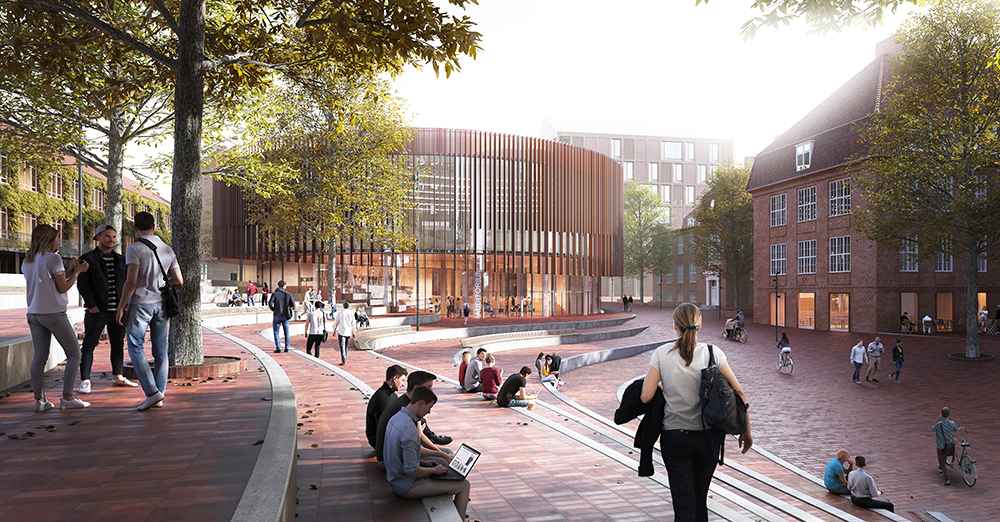
With outset in Aarhus University’s (AU) new campus, the University City, which is to be built over the next five years, AU will form the framework for an international research project to develop new tools for best building renovation practice. This will provide a framework for healthy and highly efficient green buildings.
The project is called PROBONO, and it has received EUR 20.2 million, or approx. DKK 150 million, from the EU Framework Programme for Research and Innovation, Horizon 2020. The project has 47 partners from throughout Europe.
“Aarhus University is thrilled about participating in the project, both as a research institution contributing new engineering knowledge and tools, and by physically running a Living Lab in the project; a large-scale laboratory where, as the base for a major renovation project, we will obtain real-life experience with the tools we develop,” says Eskild Holm Nielsen, dean of the Faculty of Technical Sciences at Aarhus University.
The ambition of PROBONO is to develop and test solutions for the design, construction and operation of new and/or renovated Green Building Neighbourhoods (GBN), with a positive energy balance and zero CO2 emissions. All as part of sustainable, green urban development.
This development will take place in so-called Living Labs (LLs), which the project will establish six of (Madrid, Dublin, Porto, Brussels, Prague and Aarhus). In Aarhus, the project is based on AU’s renovation of the municipal hospital, with total floorspace of 143,306 square metres, and the university’s principles for sustainable building projects with a healthy indoor climate that supports research and study environments.
“AU is implementing DGNB (Deutsche Gesellschaft für Nachhaltiges Bauen) certification for the University City as an urban area and for the buildings, but AU will also be the driving force for generating evidence and examples of everything from materials and reuse to innovative business models. There are many examples and a lot of research, from renovating schools for example, but there is only very limited research into how a university’s indoor and outside areas can create healthier, more efficient and sustainable research and learning environments. We hope to achieve this with this project,” says Aliakbar Kamari, assistant professor at the Department of Civil and Architectural Engineering and one of the leaders of the Danish part of the project.
The project will illustrate how innovative, smart technology and digitalisation can be used to benefit society. Among other things, the project will provide a GBN Digital Twin implemented across the LLs as a virtual representation of associated GBNs including operational assets that comply with today’s sustainability, emissions and health standards in a lifecycle perspective.
The 47 partners in the project come from 15 different countries. PROBONO (short for the integrator-centric approach for realising innovative energy efficient buildings in connected sustainable green neighbourhoods) will run for a total of five years (2021-2026) and has a total budget of EUR 25.3 million. The Danish partners in the project are VisBlue, COWI, GECO Global and AU.
The Danish part of the project is being carried out by researchers from the Department of Civil and Architectural Engineering and the Department of Electrical and Computer Engineering. Furthermore, researchers from the Department of Environmental Science, AU Centre for Digital Twins (DIGIT) and AU Estates Projects and Development are participating.
Buildings today are responsible for 40 per cent of total energy consumption in Europe. At the same time, up to 75 per cent of the building stock is energy-inefficient, and up to 85 per cent of it will still be in use in 2050.
This makes buildings one of the global community’s biggest energy consumers.
Politically, there is broad consensus that renovation of existing buildings has great potential for energy reductions. In fact, renovating existing buildings is crucial if Denmark is to meet its climate target of reducing carbon emissions by 70 per cent before 2030.
As Associate Professor Steffen Petersen from the Department of Civil and Architectural Engineering at Aarhus University says:
“Is renovating worthwhile, or do we have to demolish and build anew to reach our climate target? This is very case specific, but reducing the CO2 emission from existing buildings through energy renovation is absolutely vital to meet our climate targets. And when doing so, we must remember to think holistically to come up with integrated solutions that revitalise other aspects of the old buildings,” he says.
Research shows that the built environment can be an important element in promoting social relations, improving security, preventing crime, improving human health, and much more.
Moreover, many old and historic buildings are an important part of our self-perception and culture, and can also be an excellent demonstration that durability over time is also an important part of the overall climate balance.
In collaboration with Realdania, Aarhus School of Architecture, MOE A/S and others, in 2021 Aarhus University mapped existing knowledge about lifecycle assessments and conservation values relative to building culture and climate.
The study found that, on the basis of a lifecycle perspective, it is possible to reduce the climate impact of existing buildings to the same level as new buildings and at the same time maintain or strengthen the cultural and cultural-historical qualities of the buildings.
“That’s why I’m also looking forward to the experience we’ll obtain in the PROBONO project via Living Labs. The development of innovative digital solutions is an important element in achieving significant reductions in the carbon load from existing buildings. New buildings are certainly not the answer to everything, and we can come a long way with renovation,” says Steffen Petersen.